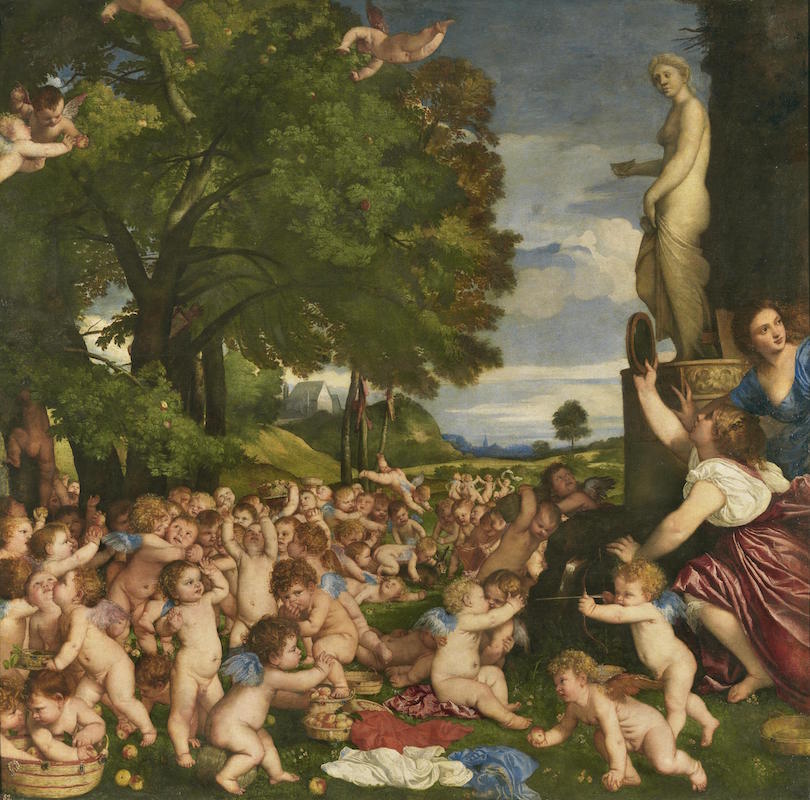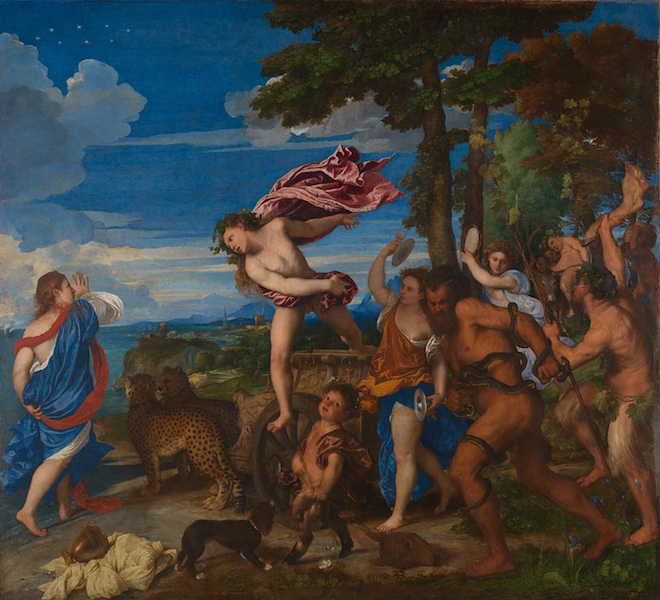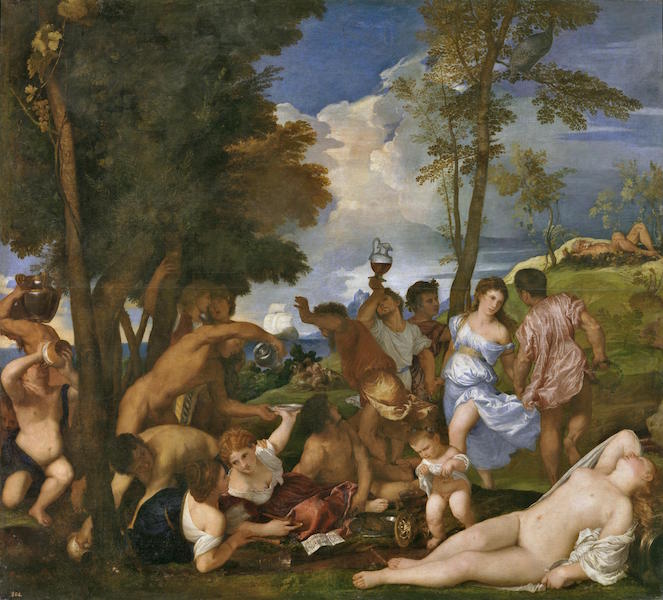
Lotis? and Priapas (detail), Giovanni Bellini and Titian, The Feast of the Gods, 1514/29, oil on canvas, 170.2 x 188 cm (National Gallery of Art)
A Divine Party
Finished just two years before Giovanni Bellini’s death, The Feast of the Gods was an unlikely subject for this Venetian master (he typically painted Christian themes and portraits). But Bellini continued to challenge himself by creating a raucous scene of 17 classical gods and goddesses eating and drinking in a lush forest clearing, painted in brilliantly rich, blended colors typical of the Venetian school of painting. Nymphs and satyrs serve wine to these classical deities. Some figures tipsily raise glasses to their lips, while others suffer the effects of having imbibed too much, staring with unfixed gazes or even passing out altogether. And the one responsible for this uninhibited celebration kneels in the left-hand foreground—the ancient Roman god of wine—Bacchus, who draws yet more of his gift from a barrel.
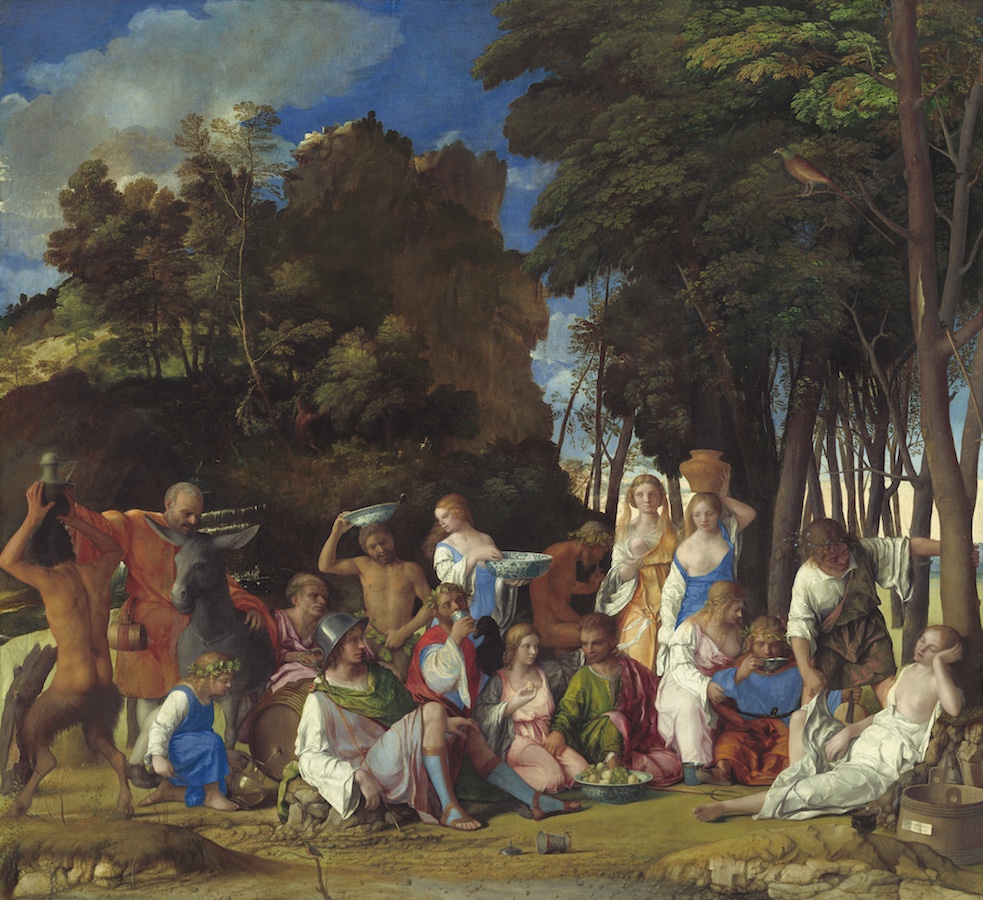
Giovanni Bellini and Titian, The Feast of the Gods, 1514/29, oil on canvas, 170.2 x 188 cm (National Gallery of Art)
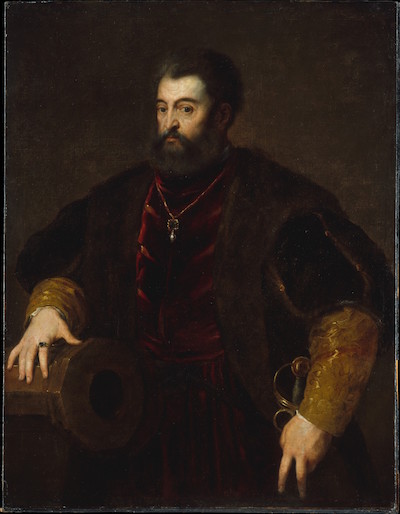
Copy after Titian, Alfonso d’Este, Duke of Ferrara, oil on canvas, 127 x 98.4 cm (The Metropolitan Museum of Art)
Changes to The Feast by Dosso Dossi and Titian
Bellini sent this large work from Venice to Alfonso d’Este, Duke of Ferrara, who intended it to hang in his camerino, his little room, as he called it, a private study modeled after an ancient painting gallery. After the canvas’s arrival in Ferrara in 1514 though, something must have gone wrong. Canvases are typically rolled for shipping and later varnished, but the painting’s surface might have been damaged in the varnishing process. Alfonso asked a local painter, Dosso Dossi (who also contributed paintings to his camerino), to repaint the left-hand background with a hill and amend the tree foliage at upper right.
Bellini had originally composed a shallow stage for his figures, behind which was a continuous line of tree trunks illuminated by warm sunlight (the only passage of which survives at the far right). But the painting today is the result of yet another change. Since Bellini died in 1516, Alfonso commissioned one of his students, the ambitious young Titian, to provide three works for his camerino, and it is Titian who painted out Dosso’s landscape with a striking mountainous backdrop, leaving only Dosso’s foliage and the pheasant in the right-hand tree.
The Feast’s subject
A consensus on the painting’s subject has yet to be reached because a number of the figures’ identities have been hotly debated. Some scholars argue a theme of marriage for the Feast’s subject. The bird, a kingfisher, in the foreground could point to the winter solstice for Alfonso’s December wedding, though it took place a decade prior to the commission. Bellini painted Bacchus unusually as a child, a guise that comes from the ancient writer Macrobius, whose book, The Saturnalia, discusses feast days, wherein Bacchus appears at four stages of life at the solstices and equinoxes of the calendar year. Bellini’s child Bacchus appears with his gluttonous teacher, Silenus, who leans on his attribute (identifying symbol), his loyal donkey.
Behind them could be the god of beginnings, Janus (sometimes identified as Sylvanus), because his hand touches his attribute, the heads of 2 snakes on the winged staff of Mercury’s attribute, the caduceus. Also in the background playing his flute is a nude Pan (or Faunus?). Jupiter with his eagle (the eagle is also an Este family symbol), appear in the center, and to the right, may be the queen of the underworld, Proserpina (or Amphitrite?). She holds a quince, a symbol of marriage to the god of the underworld, Pluto (or Neptune?), who amorously squeezes her upper thigh, while his pitchfork rests on the ground nearby. Next to him is the goddess of the harvest, Ceres (or Cybele?), wearing her wheat crown, and next to her, the god of poetry, Apollo, who with his laurel crown holds his lyre, painted as a sixteenth-century instrument, a lira da braccio.

Annotated detail, Giovanni Bellini and Titian, The Feast of the Gods, 1514/29, oil on canvas, 170.2 x 188 cm (National Gallery of Art)
Bellini consulted a text by the ancient writer Ovid titled the Fasti (Book of Days) that discusses Roman holidays in 6 books, one for each month—January through June. Bellini’s deities could, therefore, represent calendar months.
January could be represented by Janus. February is Pan. March is the child Bacchus for the spring equinox. April is Ovid’s story of the birth of spring, and the characters in the story are lined up in the foreground. Pluto had abducted Ceres’ daughter, Proserpina and Jupiter decreed that she would return to the world of the living for only half the year. As the goddess of agriculture, Ceres annually mourned her daughter’s absence, ushering in winter, halting plant growth when Proserpina resided in the underworld. Following Bellini’s sequence and Ovid’s text, then, the month of May could be for Maia, Mercury’s mother, who appears in gold. June is the fertility god Priapus at right, with his bulging phallus and scythe hanging in the tree above. Bellini here represents a story Ovid tells twice—with different victims: a nymph, Lotis (in January) or the goddess of the hearth, Vesta (in June). In both versions, Silenus’ donkey brays, awakening the sleeping lady, and foils Priapus’ erotic plot to take advantage of her.
Other works in the duke’s camerino
Characters from ancient stories seem to leap from the pages of classical books onto Alfonso’s camerino walls. He enlisted a well-read advisor to help devise later paintings’ subjects, and he tried to commission the best artists. Alfonso once climbed the Sistine Chapel scaffolding to ask Michelangelo for a painting, and he negotiated with Raphael, but both declined.
He found Titian to be more accommodating. In 1519, Titian contributed his The Worship of Venus (above), and in 1523, his Bacchus and Ariadne (above). In 1525, Titian painted his Bacchanal of the Andrians (below), a scene described in an ancient text about the island of Andros, where a stream sacred to Bacchus flowed with wine. Titian inserted details deliberately invoking comparison to his teacher’s Feast. Both feature a reclining female figure at right and an overturned wine glass in the foreground. Both have barebacked male figures carrying vessels exiting at left, and nearby, plump, inebriated fellows imbibing yet more wine. And later in 1529, Titian would repaint Bellini’s background to stylistically unite it with others of his hanging in Alfonso’s camerino, a Renaissance space dedicated to the rebirth of classical art.
Additional Resources:
Titian and Bellini, Feast of the Gods at the National Gallery of Art (high resolution available for download here)
Titian and Bellini, Feast of the Gods from Webexhibits
Titian, Bacchanal of the Andrians at the Prado
Titian, The Worship of Venus at the Prado

